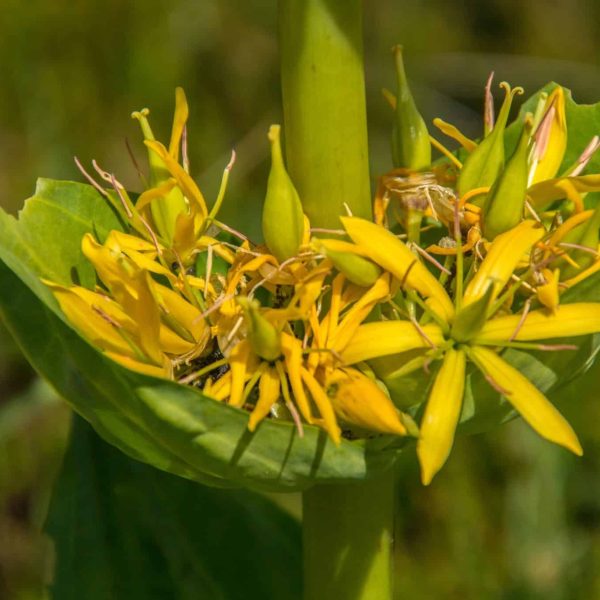-
How does it feel?
Kapikacchu is a creeping, evergreen climber that can reach heights of up to 3 metres. It has characteristically soft and downy leaves that can grow to 45cm in length. It produces clusters of purple or white, pea-like flowers during the summer that are then followed by flattened pods that grow up to 9cm in length and are soft and velvety to the touch. The pods contain 3-6 seeds that are a dark brown-orange in colour and are covered in irritant bristles. Kapikacchu is native to India and common to tropical climates where it is commonly grown as cattle fodder. There are black and white varieties of this plant.
-
What can I use it for?
Kapikacchu contains the amino acid levodopa (L-dopa), an essential precursor of dopamine. L-dopa has demonstrated the ability to breakdown monoamine oxidase (MAO), a primary indicator in Parkinson’s disease, but also in conditions characterised by nervous paralysis, cramping, tremors and spasms.
Certain alkaloids in kapikacchu increase the numbers of spermatozoa and levels of testosterone and androgens. Kapikacchu has also demonstrated improvements in levels of libido and stamina in both women and men, with increased levels of sex hormones.
-
Into the heart of kapikacchu
Kapikacchu is considered as a restorative to the nervous and reproductive system, with a specific indication in
 Parkinson’s disease. It is an excellent remedy for any nervous condition that is characterised by areas of numbness, paralysis, tremours or loss of nervous control. The presence of L-dopa in kapikacchu makes it excellent for any form of dopamine deficiency or dopamine influenced condition. The ability of kapikacchu to calm nervous spasms, has also made it a useful herb in treating digestive cramping and spasms that are exacerbated by nervous tension and stress.
Parkinson’s disease. It is an excellent remedy for any nervous condition that is characterised by areas of numbness, paralysis, tremours or loss of nervous control. The presence of L-dopa in kapikacchu makes it excellent for any form of dopamine deficiency or dopamine influenced condition. The ability of kapikacchu to calm nervous spasms, has also made it a useful herb in treating digestive cramping and spasms that are exacerbated by nervous tension and stress.In Ayurveda, kapikacchu is viewed as the ultimate restorative and tonic to the male and female reproductive system. It will rejuvenate and strengthen the organs themselves but also improves overall libido, vigour and stamina.
Kapikacchu is a tonic to the whole reproductive system in both men and women, treating low libido, infertility, impotence, spermatorrhoea and premature ejaculation. It is considered to be one of the ultimate Ayurvedic reproductive tonics for both men and women.
As it contains L-Dopa, it is a specific remedy for Parkinson’s disease (noted for the severe loss of dopamine from the basal ganglia). Its overall influence on the nervous system indicates its use in paralysis, spasms, twitching, tremors and cramps.
The anti-spasmodic function of kapikachu can help alleviate intestinal spasms, pain and gas.
-
Traditional actions
Herbal actions describe therapeutic changes that occur in the body in response to taking a herb. These actions are used to express how a herb physiologically influences cells, tissues, organs or systems. Clinical observations are traditionally what have defined these actions: an increase in urine output, diuretic; improved wound healing, vulnerary; or a reduction in fever, antipyretic. These descriptors too have become a means to group herbs by their effects on the body — herbs with a nervine action have become the nervines, herbs with a bitter action are the bitters. Recognising herbs as members of these groups provides a preliminary familiarity with their mechanisms from which to then develop an understanding of their affinities and nuance and discern their clinical significance.
-
Traditional energetic actions
Herbal energetics are the descriptions Herbalists have given to plants, mushrooms, lichens, foods, and some minerals based on the direct experience of how they taste, feel, and work in the body. All traditional health systems use these principles to explain how the environment we live in and absorb, impacts our health. Find out more about traditional energetic actions in our article “An introduction to herbal energetics“.
Western energetics
-
Did you know?
One of the common names of this herb is ‘cowhage’ reflecting its traditional use and cultivation as cattle fodder.
Additional information
-
Safety
Not for people on medication of Levodopa.
-
Dosage
5–15g/day as powder or in a decoction, or 6–20ml of a 1:3 in 25% tincture.




























 Parkinson’s disease. It is an excellent remedy for any nervous condition that is characterised by areas of numbness, paralysis, tremours or loss of nervous control. The presence of L-dopa in kapikacchu makes it excellent for any form of dopamine deficiency or dopamine influenced condition. The ability of kapikacchu to calm nervous spasms, has also made it a useful herb in treating digestive cramping and spasms that are exacerbated by nervous tension and stress.
Parkinson’s disease. It is an excellent remedy for any nervous condition that is characterised by areas of numbness, paralysis, tremours or loss of nervous control. The presence of L-dopa in kapikacchu makes it excellent for any form of dopamine deficiency or dopamine influenced condition. The ability of kapikacchu to calm nervous spasms, has also made it a useful herb in treating digestive cramping and spasms that are exacerbated by nervous tension and stress.




